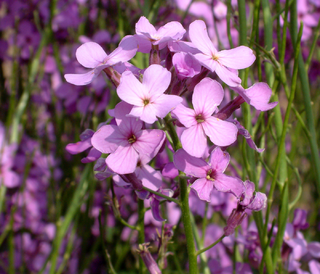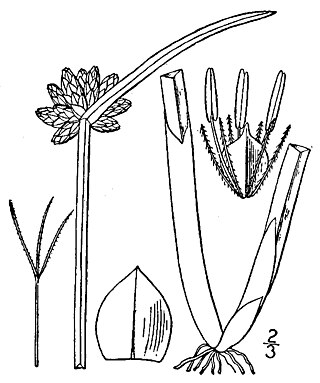
Caryophyllaceae, commonly called the pink family or carnation family, is a family of flowering plants. It is included in the dicotyledon order Caryophyllales in the APG III system, alongside 33 other families, including Amaranthaceae, Cactaceae, and Polygonaceae. It is a large family, with 81 genera and about 2,625 known species.

Asclepias is a genus of herbaceous, perennial, flowering plants known as milkweeds, named for their latex, a milky substance containing cardiac glycosides termed cardenolides, exuded where cells are damaged. Most species are toxic to humans and many other species, primarily due to the presence of cardenolides. However, as with many such plants, some species feed upon them or from them. The most notable of them is the monarch butterfly, which uses and requires certain milkweeds as host plants for their larvae.

Cirsium vulgare, the spear thistle, bull thistle, or common thistle, is a species of the Asteraceae genus Cirsium, native throughout most of Europe, Western Asia, and northwestern Africa. It is also naturalised in North America, Africa, and Australia and is an invasive weed in several regions. It is the national flower of Scotland.

Hesperis matronalis is an herbaceous flowering plant species in the family Brassicaceae. It has numerous common names, including dame's rocket, damask-violet, dame's-violet, dames-wort, dame's gilliflower, night-scented gilliflower, queen's gilliflower, rogue's gilliflower, sweet rocket, and mother-of-the-evening.

A wildflower is a flower that grows in the wild, meaning it was not intentionally seeded or planted. The term implies that the plant is neither a hybrid nor a selected cultivar that is any different from the native plant, even if it is growing where it would not naturally be found. The term can refer to the whole plant, even when not in bloom, and not just the flower.

Nicotiana glauca is a species of flowering plant in the tobacco genus Nicotiana of the nightshade family Solanaceae. It is known by the common name tree tobacco. Its leaves are attached to the stalk by petioles, and its leaves and stems are neither pubescent nor sticky like Nicotiana tabacum. It resembles Cestrum parqui but differs in the form of leaves and fusion of the outer floral parts. It grows to heights of more than two meters.

Agrostemma githago, the common corn-cockle, is a herbaceous annual flowering plant a member of Caryophyllaceae, also called the pink family or the carnation family of plants. The name of this genus is derived from Greek: agros (αργοσ) “field” and stemma (στέμμα) “garland, crown."

Ambrosia artemisiifolia, with the common names common ragweed, annual ragweed, and low ragweed, is a species of the genus Ambrosia native to regions of the Americas.

Soliva sessilis, one of up to nine species of the genus Soliva, is a low-growing herbaceous annual plant. Its common names include field burrweed, Onehunga-weed, lawn burrweed, lawnweed, jo-jo weed and common soliva. It is one of several plants also known as bindi weed, bindii, or bindi-eye.

Osteospermum moniliferum is an evergreen flowering shrub or small tree in the daisy family, Asteraceae. It is native to southern Africa, ranging through South Africa and Lesotho to Mozambique and Zimbabwe.
The soil seed bank is the natural storage of seeds, often dormant, within the soil of most ecosystems. The study of soil seed banks started in 1859 when Charles Darwin observed the emergence of seedlings using soil samples from the bottom of a lake. The first scientific paper on the subject was published in 1882 and reported on the occurrence of seeds at different soil depths. Weed seed banks have been studied intensely in agricultural science because of their important economic impacts; other fields interested in soil seed banks include forest regeneration and restoration ecology.

Pentaglottis is a monotypic genus of flowering plants in the family Boraginaceae. It is represented by a single species, Pentaglottis sempervirens, commonly known as green alkanet or evergreen bugloss, and it is one of several related plants known as alkanet. It is a bristly, perennial plant native to southwestern Europe, in northwest Iberia and France.

Viola sororia, known commonly as the common blue violet, is a short-stemmed herbaceous perennial plant native to eastern North America. It is known by a number of common names, including common meadow violet, purple violet, woolly blue violet, hooded violet, and wood violet.

Old maid's pink is a common name for several plants and may refer to:

An archaeophyte is a plant species which is non-native to a geographical region, but which was an introduced species in "ancient" times, rather than being a modern introduction. Those arriving after are called neophytes.

White Carpathians Protected Landscape Area is one of the 14 protected landscape areas in Slovakia. The Landscape Area protects the Slovak part of the White Carpathians, part of the Slovak-Moravian Carpathians, in West Slovakia. The area stretches from Skalica District in the south west to the Púchov District in the north east, copying the border between Slovakia and the Czech Republic and is about 80 km long.

A weed is a plant considered undesirable in a particular situation, growing where it conflicts with human preferences, needs, or goals. Plants with characteristics that make them hazardous, aesthetically unappealing, difficult to control in managed environments, or otherwise unwanted in farm land, orchards, gardens, lawns, parks, recreational spaces, residential and industrial areas, may all be considered weeds. The concept of weeds is particularly significant in agriculture, where the presence of weeds in fields used to grow crops may cause major losses in yields. Invasive species, plants introduced to an environment where their presence negatively impacts the overall functioning and biodiversity of the ecosystem, may also sometimes be considered weeds.

Artemisia biennis is a species of sagebrush known by the common name biennial wormwood. It is a common and widely distributed weed, so well established in many places that its region of origin is difficult to ascertain. This species is most likely native to northwestern North America and naturalized in Western Europe, and eastern and southern North America.

Schoenoplectiella mucronata is a species of flowering plant in the sedge family known by the common names bog bulrush, rough-seed bulrush, and ricefield bulrush. It is native to Eurasia, Africa and Australia. It grows in moist and wet terrestrial habitat, and in shallow water. It is a perennial herb growing from a short, hard rhizome. The erect, three-angled stems grow in dense clumps and can reach a metre tall. The leaves take the form of sheaths wrapped around the base of stem, but they generally do not have blades. The inflorescence is a headlike cluster of cone-shaped spikelets accompanied by an angled, stiff bract which may look like a continuation of the stem.


















